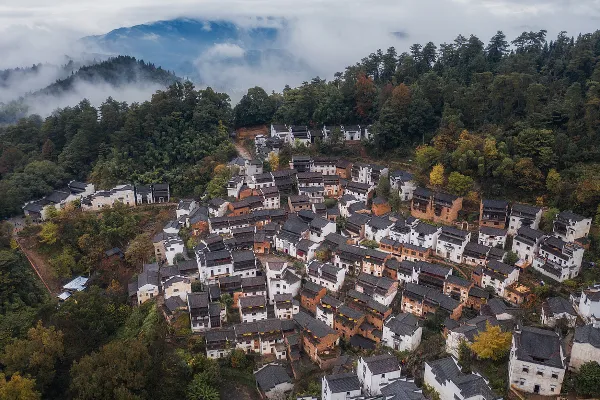
Huangling Scenic Area is located in Jiangwan Town, Wuyuan County, Shangrao City, Jiangxi Province. As a national 5A-level tourist attraction and one of China's most distinctive rural destinations, this 5-square-kilometer ancient Huizhou village at about 500m altitude boasts 580+ years history. Famous for its "sun-drying autumn harvests, terraced flower fields, and Huizhou architecture", it's acclaimed as "China's Most Beautiful Village" and "World's Most Beautiful Village".
History and Culture
Established during Ming Dynasty's Xuande era (1426-1435), Huangling preserves complete Huizhou architectural styles and cultural characteristics. Its prosperity during Ming-Qing periods from tea and mountain products trade is evidenced by remaining ancient tea and merchant trails. Most villagers surnamed Cao allegedly descend from Cao Cao of Three Kingdoms, with ancestral halls preserved.
The centuries-old "Sun-Drying Autumn" tradition sees villagers air-drying chilies, corn, chrysanthemums etc. around houses every fall, creating unique landscapes that now attract countless photographers and tourists as Huangling's iconic scene.
Its architecture epitomizes Huizhou style with white walls, black tiles, horse-head gables, and exquisite carvings. Recognized as "China's Most Beautiful Leisure Village" in 2014, Huangling's architectural and cultural values are highly regarded.
Main Attractions
Sun-Drying Households
Huangling's most distinctive September-November spectacle features vibrant agricultural products sun-dried around houses. Chilies, corn, and chrysanthemums glowing in sunlight contrast beautifully with Huizhou architecture. Multiple viewing platforms offer panoramic perspectives of this unique farming culture.
Terraced Flower Fields
The nearly 1,000-mu (67-hectare) terraces present breathtaking layered landscapes. Spring rapeseed flowers create golden seas complementing white-walled buildings, while autumn rice fields harmonize with sun-drying scenes. Pathways and platforms allow close appreciation.
Sky Street
This 600m-long main street with flagstone paving and shops retains Ming-Qing commercial layouts, typically combining storefronts with residences. Traditional workshops like oil-pressing mills and tofu makers demonstrate ancient techniques.
Leixin Glass Bridge
The 298m-long, 97m-high suspension glass bridge spanning two mountains offers thrilling panoramic village and terrace views. Its transparent sections provide exhilarating walks, making it a top attraction.
Ancient Huangling Village
Built along mountains, the well-preserved village contains 100+ Ming-Qing buildings including dwellings, ancestral halls, and academies. Its maze-like alleys and museums showcasing Wuyuan's traditional tools and folk culture exemplify Huizhou architectural refinement.
Cuisine
Wuyuan Steamed Rice Cake
This traditional snack made from rice milk gains unique fragrance from local mugwort. Huangling's time-honored shops serving freshly made cakes are visitor favorites.
Pouch-Style Red Carp
A Wuyuan specialty using local red carp stuffed with mushrooms and ham like a pouch. Tender fish with rich broth is a banquet staple available at scenic area restaurants.
Qingming Guo
These traditional seasonal glutinous rice cakes with mugwort juice come in savory (bacon, dried tofu) or sweet (sesame, sugar) fillings. Originally a Qingming Festival treat, they're now available year-round.
Nearby Cuisine
Wuyuan also offers thick tofu, steamed pork with rice flour, and wine-fermented fish. County restaurants serve authentic farmhouse cuisine with fresh ingredients.
Ticket Information
Admission: 145 yuan (includes village and terraces). Glass bridge: 60 yuan. Discounts for students/seniors. Hours: 7:30-17:30 (suggested visit: 4-5 hours).
Recommended Itinerary
Suggested route: Explore ancient village; stroll Sky Street; lunch on local dishes; visit terraces and sun-drying scenes; experience glass bridge for overviews. Overnight stays allow appreciating dawn/dusk village charm.
Transportation
- Airplane: Nearest is Jingdezhen Luojia Airport (~80km away)
- High-speed rail: To Wuyuan Station, then tourist bus (~40 minutes)
- Self-driving: ~3.5 hours from Nanchang via Dechang and Hangrui Expressways
- Internal transport: Main sites within walking distance
Must-see Attractions
- Sun-Drying Households: Iconic agricultural culture spectacle
- Terraced Flower Fields: Vast seasonal landscapes (spring flowers/autumn grains)
- Sky Street: 600m Ming-Qing commercial street with traditional workshops
- Leixin Glass Bridge: 298m suspension bridge for panoramic views
- Ancient Village: 100+ well-preserved Huizhou buildings
Travel Tips
- Best seasons: Spring-autumn (March-April for rapeseed flowers, September-November for sun-drying)
- Suggested duration: Half to full day
- Wear comfortable shoes - slippery flagstone paths
- Caution on glass bridge - not for acrophobes
- Try local specialties and buy Wuyuan green tea
- Photographers: optimal light at dawn/dusk
Precautions
- Protect ancient architecture - no carving on walls/columns
- Respect local customs - don't touch drying crops
- Secure personal belongings - crowded areas
- Walk carefully in rain - narrow alleys
- Purchase souvenirs at authorized shops for quality
- Avoid disrupting villagers' daily life when photographing